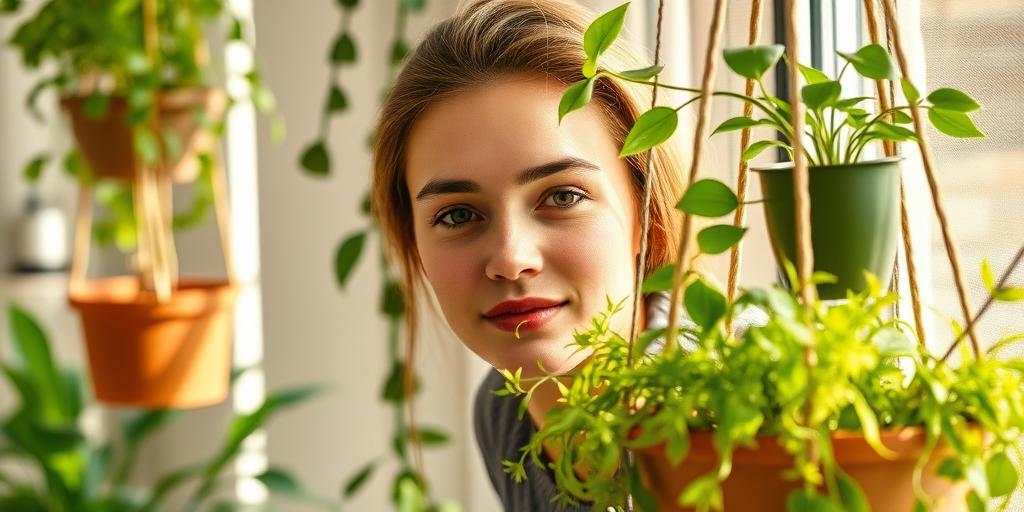
Easiest Low-Maintenance Hanging Plants for Low Light (2025)
Discover the easiest low-maintenance hanging plants for low light! Perfect for busy plant lovers, these resilient beauties thrive with minimal care—ideal for dim corners and urban spaces.
Introduction
Do you love greenery but struggle with low-light spaces? You’re not alone! Many homes and offices lack bright sunlight, but that doesn’t mean you can’t enjoy lush, cascading plants. Hanging plants add life to any room, and the best part? Some varieties thrive on neglect! In this guide, we’ll explore the easiest low-maintenance hanging plants that flourish in low light—perfect for beginners or anyone who wants effortless greenery.
Why Choose Low-Maintenance Hanging Plants for Low Light?
If you love the idea of lush greenery but don’t have the time (or sunlight) to keep high-maintenance plants alive, low-light hanging plants are the perfect solution. They’re ideal for busy lifestyles because they require minimal watering and care. Forget about daily attention—these plants thrive even when you occasionally forget about them.
They’re also a great fit for apartments, offices, or any room with limited natural light. No south-facing window? No problem. Many of these plants adapt well to artificial lighting, making them perfect for spaces where sunlight is scarce.
Beyond their easy-care nature, many low-light hanging plants offer air-purifying benefits, helping to remove toxins from indoor spaces. Plus, their trailing vines or cascading leaves add aesthetic appeal without demanding constant pruning or fuss.
Top Low-Maintenance Hanging Plants for Low Light
1. Pothos (Devil’s Ivy)
Pothos is a superstar when it comes to low-maintenance hanging plants. It thrives in low to moderate light and can even survive in fluorescent office lighting. One of its best features? It tolerates irregular watering—perfect if you’re prone to forgetting your plant-care duties.
The vines trail beautifully, making it a great choice for shelves, hanging baskets, or even as a tabletop plant with some creative draping. There are several varieties to choose from, including the classic Golden Pothos (with its yellow variegation), the striking Marble Queen (white and green leaves), and the vibrant Neon Pothos (bright lime green).
2. Spider Plant
Spider plants are another excellent option for low-light spaces. They adapt well to dim conditions and can even grow under artificial lighting. One of their coolest features is their ability to produce “spiderettes”—tiny baby plants that dangle from the mother plant. These can be easily propagated to grow even more plants.
They’re also pet-friendly, so you don’t have to worry if your cat or dog takes a curious nibble. Plus, spider plants are great for air purification, helping to remove common indoor pollutants like formaldehyde.
3. Philodendron Heartleaf
If you’re looking for a fast-growing, low-light plant with a romantic touch, the Philodendron Heartleaf is a fantastic pick. Its heart-shaped leaves add a charming aesthetic, and it thrives in dim corners where other plants might struggle.
Watering is simple—just wait until the soil is dry before giving it a drink. This plant is forgiving and bounces back quickly if you accidentally neglect it for a bit. It’s also a prolific grower, so you’ll have long, trailing vines in no time.
4. ZZ Plant (Zamioculcas Zamiifolia)
The ZZ plant is practically indestructible, making it perfect for anyone who tends to forget about their plants. It thrives on neglect and can go weeks without water. Its glossy, dark green leaves add an elegant touch to any space, and it grows well in low-light conditions.
This plant is drought-tolerant, so overwatering is a bigger risk than underwatering. If you’re the type who travels often or just doesn’t want to worry about frequent plant care, the ZZ plant is a no-brainer.
5. String of Hearts
For something a little more delicate and whimsical, the String of Hearts is a gorgeous trailing plant with small, heart-shaped leaves. While it prefers bright indirect light, it can tolerate low-light conditions, though its growth may slow down.
Its succulent-like nature means it has low water needs—let the soil dry out completely between waterings. The vines can grow quite long, making it a stunning choice for hanging planters where its trailing foliage can really shine.
Care Tips for Low-Light Hanging Plants
Even though these plants are low-maintenance, a few simple care tips will help them thrive:
-
Water sparingly: Overwatering is the #1 killer of indoor plants. Always let the soil dry out between waterings—stick your finger in the soil to check moisture levels before reaching for the watering can.
-
Dust leaves occasionally: Dust can block light absorption, especially in low-light conditions. Wipe leaves gently with a damp cloth to keep them clean and efficient at photosynthesis.
-
Rotate plants: Since light is limited, rotating your plants every few weeks ensures all sides get some exposure, promoting even growth.
-
Avoid direct sunlight: Many low-light plants are sensitive to harsh sunlight, which can scorch their leaves. Keep them away from south-facing windows unless filtered by sheer curtains.
Best Places to Hang Low-Light Plants
Wondering where to place your low-light hanging plants? Here are some great spots:
-
Bathrooms: Humidity-loving varieties like Pothos thrive in the moisture-rich air of bathrooms. Just make sure there’s at least some indirect light.
-
Office cubicles or bookshelves: Spider plants and ZZ plants do well under fluorescent lighting, making them perfect for workspaces.
-
Dark corners or hallways: Brighten up neglected spaces with a trailing Philodendron or String of Hearts.
-
North-facing windows: These windows provide gentle, indirect light—ideal for plants that can’t handle intense sun exposure.
With the right plant choices and a little basic care, you can enjoy lush greenery even in the darkest corners of your home or office.
Conclusion
Who says low-light spaces have to stay dull? With these easy-care hanging plants, you can transform dim areas into lush, green retreats—no green thumb required! Whether you opt for a hardy Pothos or an elegant ZZ plant, these resilient varieties will thrive with minimal effort. Ready to brighten up your space? Pick your favorite and let nature do the rest!
